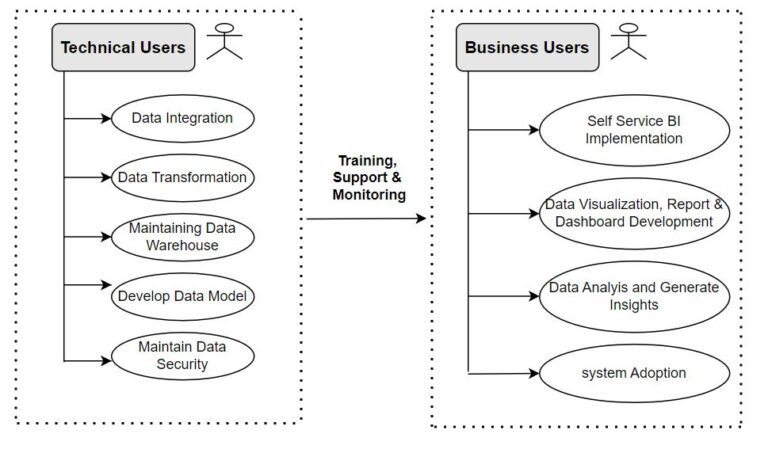Self-Service BI Tools: Empowering Non-Technical Users – Self-Service BI Tools Empowering Non-Technical Users opens the door to a world where data-driven decision-making is no longer confined to technical experts. With the growing importance of data in all facets of business, these tools allow everyday users to access, analyze, and visualize data independently. This shift not only democratizes data access but also enhances organizational efficiency by enabling quicker insights and fostering a culture of informed decision-making.
As more companies recognize the value of self-service BI tools, understanding their functionality and benefits becomes essential. These platforms simplify complex data processes, empowering users without a technical background to create reports and dashboards effortlessly. From enhancing productivity to driving strategic growth, self-service BI tools are transforming how organizations leverage data to make impactful decisions.
Communication is an integral part of our daily lives. Whether we are speaking to a colleague, a friend, or a stranger, the way we convey our thoughts and feelings can significantly impact our relationships and overall success. In this article, we will explore the fundamentals of effective communication, the barriers that often hinder it, and some practical tips to enhance your conversational skills.
Understanding Communication
At its core, communication is the process of exchanging information, thoughts, and feelings between individuals. It can take many forms, including verbal, non-verbal, written, and visual communication. Each type has its own nuances and can evoke different responses. For instance, a smile can convey warmth and openness, while a frown might communicate disapproval or confusion.
Effective communication is not just about speaking clearly or using the correct words; it’s also about understanding your audience and adapting your message accordingly. This adaptability is essential in fostering meaningful connections and ensuring that your message is received as intended.
Barriers to Effective Communication
Several factors can impede effective communication. Understanding these barriers is the first step in overcoming them. Here are some common obstacles:

- Language Differences: Sometimes, the most straightforward concepts can become complicated due to language barriers. This can occur in cross-cultural communications where idioms, slang, or even body language may not translate well.
- Emotional Barriers: Our emotions can greatly influence how we communicate. Stress, anxiety, or anger can lead to misunderstandings and misinterpretations.
- Physical Barriers: Noise, distance, or poor technology can interrupt the flow of conversation, making it difficult to hear or engage fully.
- Perceptual Barriers: Our individual perceptions can color how we interpret messages. Past experiences, biases, or stereotypes may shape our understanding in ways we might not be consciously aware of.
Tips for Effective Communication: Self-Service BI Tools: Empowering Non-Technical Users
Now that we’ve identified potential barriers, let’s look at some strategies to enhance our communication skills:
1. Active Listening
One of the most critical aspects of communication is listening. Active listening involves fully concentrating, understanding, responding, and remembering what the other person is saying. To practice active listening:
- Give your full attention to the speaker. Avoid distractions such as your phone or other conversations.
- Reflect back what you’ve heard to confirm understanding. For example, “So what you’re saying is…”
- Ask clarifying questions if something is unclear. This shows you’re engaged and interested in the conversation.
2. Be Clear and Concise
When it’s your turn to speak, clarity is key. Avoid jargon or overly complex phrases that might confuse your listener. Aim to be concise, presenting your thoughts in a straightforward manner. This not only helps in reducing misunderstandings but also keeps your audience engaged.
3. Use Non-Verbal Communication
Non-verbal signals such as gestures, facial expressions, and eye contact can enhance or undermine your verbal message. Being aware of your body language can make a significant difference in how your message is perceived. For instance, maintaining eye contact can convey confidence and sincerity, while crossed arms might suggest defensiveness or disinterest.
4. Adapt to Your Audience, Self-Service BI Tools: Empowering Non-Technical Users
Different audiences require different approaches. Tailor your language, tone, and even your examples to fit the context of your conversation. For instance, speaking with a child will differ significantly from a professional setting where technical jargon may be appropriate. Understanding your audience’s background, interests, and knowledge level allows you to connect more effectively.
5. Cultivate Empathy
Empathy plays a vital role in communication. By putting yourself in the other person’s shoes, you can better understand their feelings and perspectives. This not only helps in responding appropriately but also fosters a more respectful and meaningful exchange.
The Role of Technology in Communication
In today’s digital age, technology has transformed the way we communicate. While it offers numerous advantages, such as instant messaging and video calls, it also presents challenges. Misinterpretations can arise easily in written communication due to the lack of tone and body language. Here are some tips for effective communication in a tech-driven world:
- Choose the Right Medium: Decide whether your message is best communicated via email, text, or a phone call. Complex issues may require a face-to-face or video conversation to avoid miscommunication.
- Stay Professional: Maintain a professional tone in written communications, especially in formal contexts like emails or business messaging platforms.
- Be Mindful of Timing: Consider the timing of your messages, particularly in a global context where time zones may affect when recipients will be available to respond.
Conclusion
Effective communication is an art that can be learned and refined over time. By practicing active listening, being clear and concise, and adapting your approach to your audience, you can navigate conversations with confidence. Remember that overcoming barriers to communication is a continuous process that requires patience and empathy. As you develop these skills, you will not only enhance your personal and professional relationships but also foster a more connected and understanding world.
In conclusion, take the time to reflect on your communication style and be open to feedback from others. With practice, you can become a more effective communicator, leading to greater success in all areas of your life.









